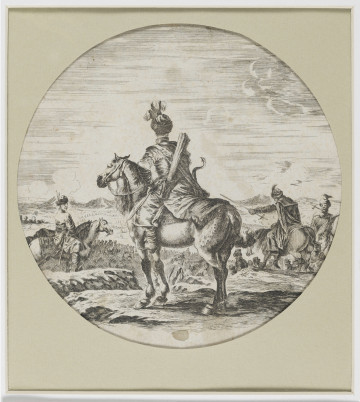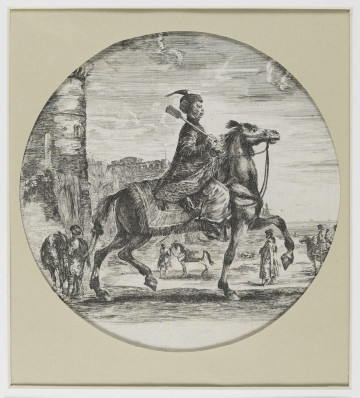
View of a Polish cavalier from behind
1651
National Museum in Lublin
Part of the collection: Portrait painting
Stefano della Bella is one of the most outstanding representatives of 17th-century Italian printmaking. His oeuvre coincided with the period when etching dominated among printmakers. The technique was used, among others, by Guido Reni, Simone Cantarini, Antonio Tempesta, Salvator Rosa, Pietro Testa, Giovanni Benedetto Castiglione. The hitherto artistic centre in Rome gave way to individual studios of graphic artists. During Stefano Della Bella's period of activity, Rome lost its previous role as a significant artistic centre favouring the individual studios of master chisel artists established in other Italian cities.
Della Bella is a draughtsman and engraver associated with the court patronage of the Grand Dukes of Tuscany and Cardinals Richelieu and Mazarin. His works cover a wide range of subjects, including ornamental series, pattern books, landscapes and a series of horse riders.
Della Bella's works documented the Polish fashion in force in the 17th century. With the reign of Stefan Batory, the country was strongly influenced by the Orient, also visible in the artist's works.
Thanks to the etching in question, we can learn about the armour and clothing of the hussars, a military formation that was fully formed during the reign of Stefan Batory. Its origins date to 15th-century Hungary. The cavalry representative's clothing consisted of a cap with a brim or a hat similar to a cylinder, a lapel with loops, mente, tight trousers and low shoes with spurs. The warrior had a light, hollow, 5-metre-long lance to kill his opponent from a distance, while swords, conkers, implements and pistols were used in close combat. They did not wear armour; a wooden shield was used for defence. A characteristic element is the wings, which have a psychological rather than functional function. They were made of feathers of birds of prey, hawks, eagles, but also dyed feathers of swans or geese were used.
Researcher Mieczysław Paszkiewicz identified the warrior on horseback as Captain Szczodrowski of the Pierzchała coat of arms.
Klara Sadkowska
Author / creator
Dimensions
cały obiekt: height: 18,6 cm, width: 18,6 cm
Object type
graphics
Technique
etching
Material
laid paper
Creation time / dating
Creation / finding place
Owner
The National Museum in Lublin
Identification number
Location / status

1651
National Museum in Lublin

1651
National Museum in Lublin

1651
National Museum in Lublin
DISCOVER this TOPIC
Castle Museum in Łańcut
DISCOVER this PATH
Educational path